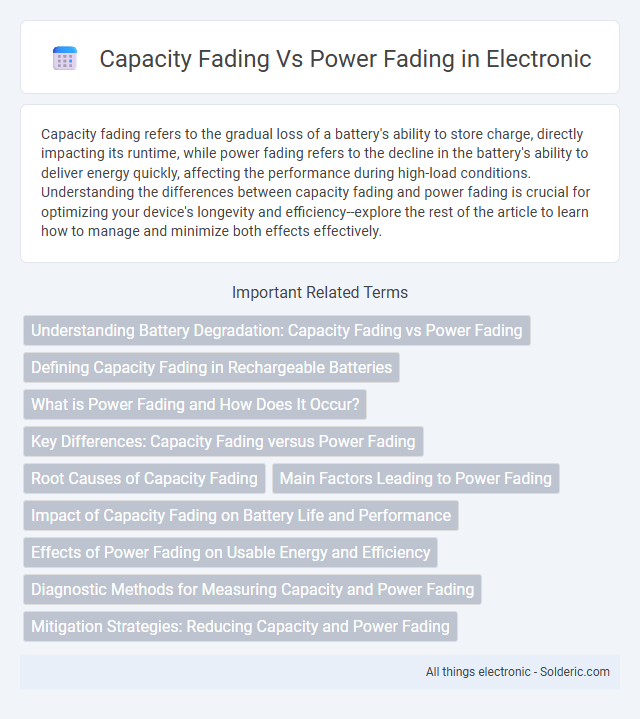Capacity fading refers to the gradual loss of a battery's ability to store charge, directly impacting its runtime, while power fading refers to the decline in the battery's ability to deliver energy quickly, affecting the performance during high-load conditions. Understanding the differences between capacity fading and power fading is crucial for optimizing your device's longevity and efficiency--explore the rest of the article to learn how to manage and minimize both effects effectively.
Comparison Table
| Aspect | Capacity Fading | Power Fading |
|---|---|---|
| Definition | Reduction in the total energy a battery can store over time | Decrease in the battery's ability to deliver power instantly |
| Primary Cause | Chemical degradation and loss of active material | Increased internal resistance and kinetic limitations |
| Effect on Battery | Lower total runtime or capacity (mAh or Ah) | Reduced maximum current output and voltage under load |
| Measurement | Capacity tests (charge/discharge cycles) | Power tests (pulse discharge, internal resistance) |
| Impact on Applications | Shorter operating time between charges | Poor performance in high power demand conditions |
| Typical Indicators | Decreased mAh, longer charge times | Voltage drop under load, heat generation |
| Common in | All rechargeable batteries with aging | High-rate discharge batteries, batteries under stress |
Understanding Battery Degradation: Capacity Fading vs Power Fading
Battery degradation manifests primarily through capacity fading and power fading, two critical factors affecting overall performance. Capacity fading refers to the gradual loss of the battery's ability to store charge, diminishing your device's runtime, while power fading describes the reduction in the battery's ability to deliver adequate current, impacting peak power output. Monitoring these degradation modes helps optimize battery life and maintain reliable energy performance over time.
Defining Capacity Fading in Rechargeable Batteries
Capacity fading in rechargeable batteries refers to the gradual reduction in the total amount of charge a battery can store and deliver over repeated charge-discharge cycles. This decline results from chemical and structural changes in electrode materials, electrolyte degradation, and solid-electrolyte interphase (SEI) growth. Unlike power fading, which impacts the battery's ability to provide high current output, capacity fading directly affects the battery's usable energy storage.
What is Power Fading and How Does It Occur?
Power fading refers to the gradual decline in a battery's ability to deliver peak power output during high-demand periods, often caused by increased internal resistance and degradation of electrode materials. It occurs as repeated charge-discharge cycles lead to structural changes, loss of active material, and electrolyte decomposition, which hinder the battery's efficiency in energy delivery. Understanding power fading is crucial for maintaining Your device's performance and optimizing battery lifespan.
Key Differences: Capacity Fading versus Power Fading
Capacity fading refers to the gradual loss of a battery's ability to store charge over repeated charge-discharge cycles, resulting in reduced total energy output. Power fading involves the decline in the battery's ability to deliver high current or power, often caused by increased internal resistance or degradation of electrode kinetics. The key difference lies in capacity fading affecting total energy capacity, while power fading impacts the rate at which energy can be accessed.
Root Causes of Capacity Fading
Capacity fading primarily results from the gradual loss of active lithium ions and the deterioration of electrode materials, which reduce the battery's ability to store charge over time. Key root causes include the formation of solid electrolyte interphase (SEI) layers, electrode material structural changes, and electrolyte decomposition. Understanding these mechanisms helps optimize your battery management strategies to extend overall battery longevity.
Main Factors Leading to Power Fading
Power fading in batteries is primarily caused by increased internal resistance due to electrode degradation, electrolyte decomposition, and loss of active material conductivity. Temperature variations accelerate side reactions, leading to the formation of resistive layers like solid electrolyte interphase (SEI) growth, which impedes ion flow and reduces peak power output. Mechanical stresses and cycling-induced structural changes also contribute to electrode delamination and contact loss, further diminishing power performance.
Impact of Capacity Fading on Battery Life and Performance
Capacity fading directly reduces the total charge a battery can hold, leading to shorter usage times and fewer charge cycles before replacement is needed. Power fading, on the other hand, diminishes the battery's ability to deliver high current, affecting device performance during peak power demands. Understanding capacity fading is crucial for managing your battery life, as it primarily determines the longevity and consistent energy supply of your device.
Effects of Power Fading on Usable Energy and Efficiency
Power fading directly reduces the peak output capability of a battery, limiting the rate at which energy can be delivered and causing a decrease in system performance under high-demand conditions. This decline in power delivery efficiency leads to suboptimal energy usage, as more energy is lost as heat during operation, reducing the usable energy over time. Understanding the effects of power fading helps you optimize battery management strategies to maintain efficiency and prolong the practical lifespan of energy storage devices.
Diagnostic Methods for Measuring Capacity and Power Fading
Electrochemical impedance spectroscopy (EIS) and cyclic voltammetry are effective diagnostic methods for measuring capacity fading and power fading in batteries, providing insights into internal resistance and charge-transfer kinetics. Capacity fading primarily reflects the loss of active material or electrolyte degradation, while power fading highlights increased internal resistance and electrode polarization. Your choice of diagnostic technique can optimize battery maintenance and performance by accurately distinguishing between these degradation mechanisms.
Mitigation Strategies: Reducing Capacity and Power Fading
Mitigation strategies for capacity and power fading in lithium-ion batteries include advanced electrode materials such as silicon-based anodes and high-nickel cathodes that enhance structural stability and electrochemical performance. Implementing optimized electrolyte formulations with additives like fluoroethylene carbonate (FEC) minimizes solid electrolyte interphase (SEI) degradation, reducing capacity loss and improving power retention. Thermal management systems and controlled charge-discharge protocols further mitigate fading by maintaining optimal operating temperatures and limiting mechanical stress on battery components.
Capacity fading vs power fading Infographic

 solderic.com
solderic.com